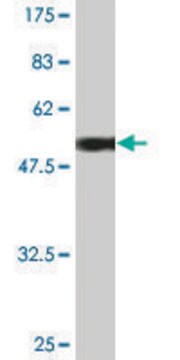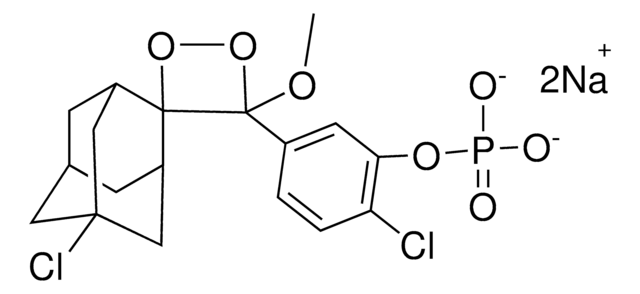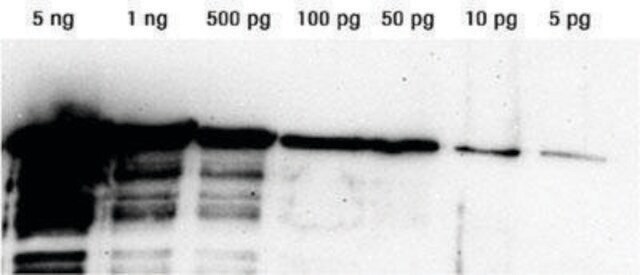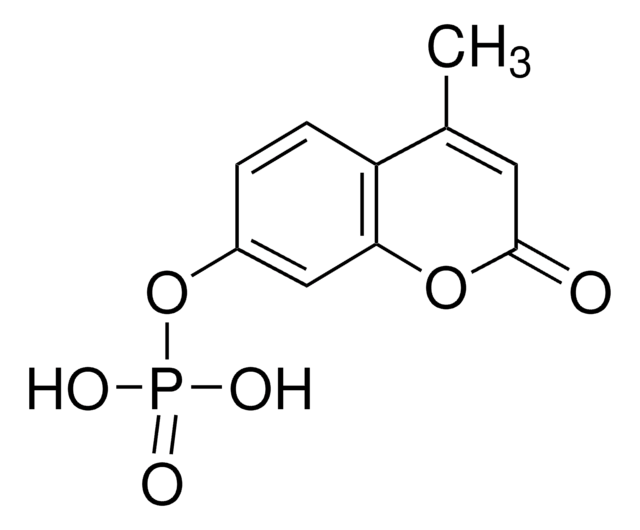11582950001
Roche
BM Chemiluminescence ELISA Substrate (POD)
Synonyme(s) :
ELISA substrate
Se connecterpour consulter vos tarifs contractuels et ceux de votre entreprise/organisme
About This Item
Code UNSPSC :
12352204
Produits recommandés
Forme
solution
Niveau de qualité
Conditionnement
pkg of 250 mL (for 2500 wells or 1000 tubes)
Fabricant/nom de marque
Roche
Conditions de stockage
(Keep container tightly closed in a dry and well-ventilated place.)
Technique(s)
ELISA: suitable
Couleur
clear colorless
Solubilité
water: miscible
Adéquation
suitable for chemiluminescence
Conditions d'expédition
wet ice
Température de stockage
2-8°C
Description générale
The sensitivity of enzyme-linked immunosorbent assays often depends on the detection limit of the colorimetric substrates used. In addition, the dynamic range of a colorimetric assay is restricted to a maximum of two orders of magnitude due to the physical/chemical limitations of absorbance measurement (Law of Lambert & Beer). With chemiluminescence technology, a nonradioactive method, which combines the convenience of tube or microplate-based immunoassays with the advantages of isotopic assays, is now available. The BM Chemiluminescence ELISA Substrate (POD) has been evaluated with different immunoassays on the LB 96 P microplate reader and the LB 953 tube chemiluminescence analyzer from EG&G;Berthold.
Application
The BM Chemiluminescence ELISA Substrate (POD) provides a substrate solution for peroxidase-based (POD, HRP) secondary detection systems with highly sensitive, enhanced chemiluminescence. This reagent has been optimized for ELISA applications to be run on a microplate chemiluminescence reader (96-well format) or tube-format luminometers.
Caractéristiques et avantages
- Improved sensitivity
- Large dynamic range
- Rapid and constant signal
Contents
Substrate Reagent A (buffered solution that contains luminol/4-iodophenol)
Starting Reagent B (buffered solution that contains a stabilized form of H2O2)
Principe
Horseradish peroxidase (POD, HRP), in the presence of hydrogen peroxide (H2O2), catalyzes the oxidation of diacylhydrazides such as luminol. A reaction product in an excited state is thus formed, then decays to the ground state by emitting light. Strong enhancement of the light emission is achieved by the agent 4-iodophenol (contained), which acts as a radical transmitter between the formed oxygen radical and luminol.
Notes préparatoires
Working solution: Preparation of working solution
The BM Chemiluminescence ELISA Substrate is supplied as a set of two stable solutions. Depending on the scale of the assay, the appropriate amount of substrate solution has to be prepared 15 minutes before use:
Storage conditions (working solution): The premixed solution is stable for 1 week, when stored at 2 to 8 °C.
The BM Chemiluminescence ELISA Substrate is supplied as a set of two stable solutions. Depending on the scale of the assay, the appropriate amount of substrate solution has to be prepared 15 minutes before use:
- Add to 100 parts of solution A one part of solution B.
- Stir the mixture for at least 15 minutes at 15 to 25 °C to equilibrate the components.
Storage conditions (working solution): The premixed solution is stable for 1 week, when stored at 2 to 8 °C.
Autres remarques
For life science research only. Not for use in diagnostic procedures.
Code de la classe de stockage
12 - Non Combustible Liquids
Classe de danger pour l'eau (WGK)
WGK 1
Point d'éclair (°F)
does not flash
Point d'éclair (°C)
does not flash
Faites votre choix parmi les versions les plus récentes :
Déjà en possession de ce produit ?
Retrouvez la documentation relative aux produits que vous avez récemment achetés dans la Bibliothèque de documents.
Les clients ont également consulté
Hayley Dingsdale et al.
Journal of psychiatric research, 150, 47-53 (2022-03-31)
Altered serum levels of brain-derived neurotrophic factor (BDNF) are consistently linked with neurological disorders. BDNF is also increasingly implicated in the pathogenesis of neurodevelopmental disorders, particularly those found more frequently in males. At birth, male infants naturally have significantly lower
Adam Zwolak et al.
Scientific reports, 12(1), 20538-20538 (2022-11-30)
TL1A (TNFSF15) is a TNF superfamily ligand which can bind the TNFRSF member death receptor 3 (DR3) on T cells and the soluble decoy receptor DcR3. Engagement of DR3 on CD4+ or CD8+ effector T cells by TL1A induces downstream signaling, leading
Stefania Kalogera et al.
Scientific reports, 11(1), 24285-24285 (2021-12-22)
Osteoarthritis (OA) and rheumatoid arthritis (RA) are serious and painful diseases. Protease-activated receptor 2 (PAR2) is involved in the pathology of both OA and RA including roles in synovial hyperplasia, cartilage destruction, osteophyogenesis and pain. PAR2 is activated via cleavage
F Gagné et al.
Comparative biochemistry and physiology. Toxicology & pharmacology : CBP, 153(1), 99-106 (2010-09-28)
The endocrine-disrupting activity of municipal effluents has the potential to alter the reproductive system and induce feminization to aquatic organisms. The purpose of this study was to examine the sex ratio, vitellogenin (Vtg)-like proteins, serotonin, arachidonate cyclooxygenase (COX) activity and
Suvoshree Ghosh et al.
Human mutation, 43(1), 42-55 (2021-11-25)
γ-Glutamyl carboxylase (GGCX) catalyzes the γ-carboxylation of 15 different vitamin K dependent (VKD) proteins. Pathogenic variants in GGCX cause a rare hereditary bleeding disorder called Vitamin K dependent coagulation factor deficiency type 1 (VKCFD1). In addition to bleedings, some VKCFD1
Notre équipe de scientifiques dispose d'une expérience dans tous les secteurs de la recherche, notamment en sciences de la vie, science des matériaux, synthèse chimique, chromatographie, analyse et dans de nombreux autres domaines..
Contacter notre Service technique

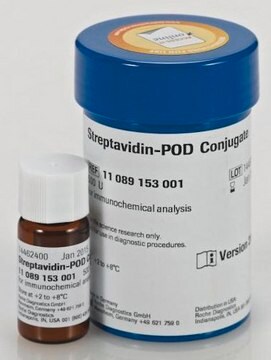
![BM Chemiluminescence Western Blotting Substrate (POD) pkg of 1 set (11500708001 [1,000 cm2 membrane]), pkg of 1 set (11500694001 [4,000 cm2 membrane])](/deepweb/assets/sigmaaldrich/product/images/352/091/ef743cea-ccd8-44f1-8f3b-dec5a1e4f5d1/640/ef743cea-ccd8-44f1-8f3b-dec5a1e4f5d1.jpg)
